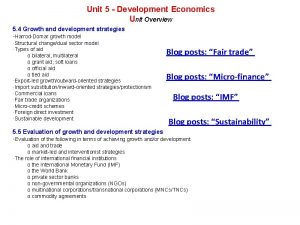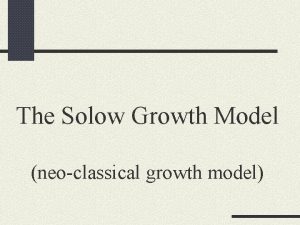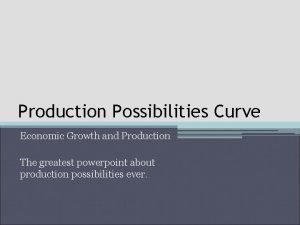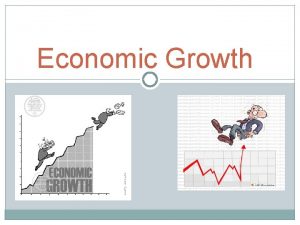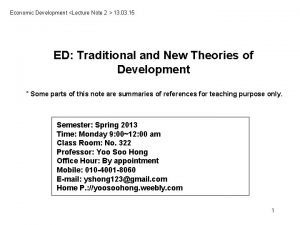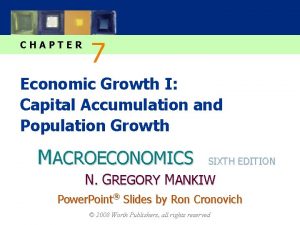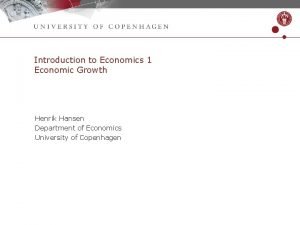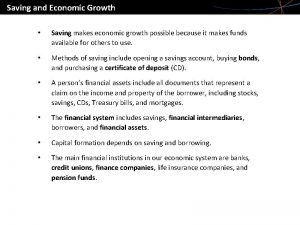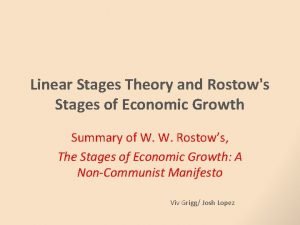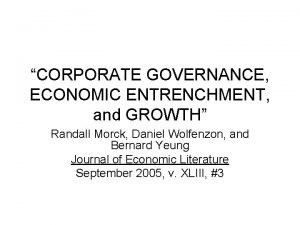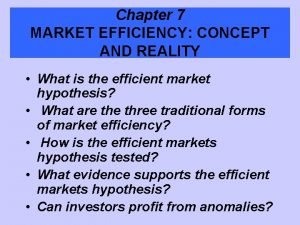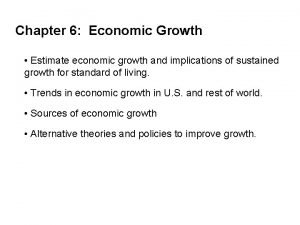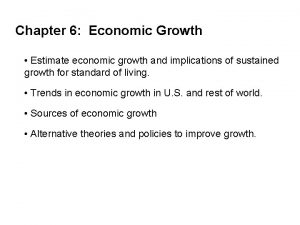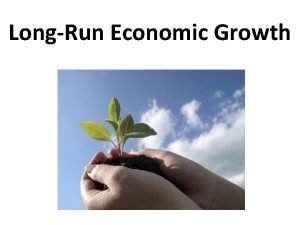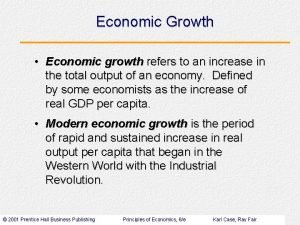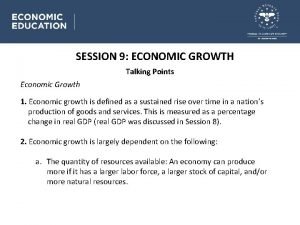CHAPTER 5 The Reality of Economic Growth History


































































- Slides: 66

CHAPTER 5 The Reality of Economic Growth: History and Prospect 1 Copyright © 2002 by The Mc. Graw-Hill Companies, Inc. All rights reserved.

Questions • What is modern economic growth? • What was the post-1973 productivity slowdown? – What were its causes? – Is the productivity slowdown now over? • Why are some nations so (relatively) rich and other nations so (relatively) poor? 2 Copyright © 2002 by The Mc. Graw-Hill Companies, Inc. All rights reserved.

Questions • What policies can make economic growth faster? • What are the prospects for successful and rapid economic development in tomorrow’s world? 3 Copyright © 2002 by The Mc. Graw-Hill Companies, Inc. All rights reserved.

Looking Back into Deep Time • Up until 1500, there had been almost zero growth of output per worker • After 1800, we see large sustained increases in worldwide standards of living – population growth accelerated – output per capita grew 4 Copyright © 2002 by The Mc. Graw-Hill Companies, Inc. All rights reserved.

Table 5. 1 - Economic Growth through Deep Time 5 Copyright © 2002 by The Mc. Graw-Hill Companies, Inc. All rights reserved.

Figure 5. 1 - World Population Growth since 1000 6 Copyright © 2002 by The Mc. Graw-Hill Companies, Inc. All rights reserved.

Premodern Economic “Growth” • Thomas R. Malthus – first academic professor of economics – introduced the idea that increases in technology inevitably run into natural resource scarcity • implies that increases in technology lead to an increase in the size of the population but not to an increase in the standard of living 7 Copyright © 2002 by The Mc. Graw-Hill Companies, Inc. All rights reserved.

The End of the Malthusian Age • Over time, the rate of technological progress rose – by 1500, it was sufficiently high so that natural resource scarcity could not surpass it – sustained increases in the population and the productivity of labor followed 8 Copyright © 2002 by The Mc. Graw-Hill Companies, Inc. All rights reserved.

The Demographic Transition • As material standards of living rise far above subsistence, countries undergo a demographic transition – birth rates rise – death rates fall – birth rates fall 9 Copyright © 2002 by The Mc. Graw-Hill Companies, Inc. All rights reserved.

Figure 5. 2 - Stylized Picture of the Demographic Transition 10 Copyright © 2002 by The Mc. Graw-Hill Companies, Inc. All rights reserved.

The Demographic Transition • In the world today, not all countries have gone through their demographic transitions – Nigeria, Iraq, Pakistan, and the Congo are projected to have population growth rates greater than 2% per year over the next generation 11 Copyright © 2002 by The Mc. Graw-Hill Companies, Inc. All rights reserved.

Figure 5. 3 - Expected Population Growth Rates, 1997 -2015 12 Copyright © 2002 by The Mc. Graw-Hill Companies, Inc. All rights reserved.

Figure 5. 3 - Expected Population Growth Rates, 1997 -2015 13 Copyright © 2002 by The Mc. Graw-Hill Companies, Inc. All rights reserved.

The Industrial Revolution • The industrial revolution began the era of modern economic growth – new technological leaps revolutionized industries and generated major improvements in living standards • Great Britain was the center of the industrial revolution – English became the world’s de facto second language 14 Copyright © 2002 by The Mc. Graw-Hill Companies, Inc. All rights reserved.

The Industrial Revolution • The new technologies were not confined to Great Britain – spread rapidly to western Europe and the United States – spread less rapidly to southern and eastern Europe and Japan 15 Copyright © 2002 by The Mc. Graw-Hill Companies, Inc. All rights reserved.

Figure 5. 4 - Industrialized Areas of the World, 1870 16 Copyright © 2002 by The Mc. Graw-Hill Companies, Inc. All rights reserved.

American Long-Run Growth, 1800 -1973 • Growth in the second half of the nineteenth century was faster than it had been in the first half • Growth accelerated further in the early part of the twentieth century – a second wave of industrialization occurred from new inventions and innovations 17 Copyright © 2002 by The Mc. Graw-Hill Companies, Inc. All rights reserved.

American Long-Run Growth, 1800 -1973 • Growth slowed slightly during the Great Depression and World War II – 1. 4 percent per year from 1929 to 1950 • Growth accelerated from 1950 to 1973 18 Copyright © 2002 by The Mc. Graw-Hill Companies, Inc. All rights reserved.

Figure 5. 5 - U. S. Measured Economic Growth: Real GDP per Worker 1995 Prices, 1890 -1995 19 Copyright © 2002 by The Mc. Graw-Hill Companies, Inc. All rights reserved.

American Long-Run Growth, 1800 -1973 • Many economists believe that official estimates of output per worker overstate inflation and understate real economic growth by 1 percent per year – national income accountants have a hard time valuing the boost to productivity and standards of living generated by new inventions 20 Copyright © 2002 by The Mc. Graw-Hill Companies, Inc. All rights reserved.

American Long-Run Growth, 1800 -1973 • Structural changes also occurred – large drop in the proportion of the labor force working as farmers occurred – new methods of travel were developed – large number of innovative technologies and business practices were adopted 21 Copyright © 2002 by The Mc. Graw-Hill Companies, Inc. All rights reserved.

American Long-Run Growth, 1800 -1973 • The U. S. became the world’s leader (in terms of technology) during the twentieth century because – the U. S. had an exceptional commitment to education – the U. S. was the largest market in the world – the U. S. was extraordinarily rich in natural resources 22 Copyright © 2002 by The Mc. Graw-Hill Companies, Inc. All rights reserved.

American Economic Growth Since 1973 • Between 1973 and 1995 measured output per worker grew at only 0. 6 percent per year • The other major industrial economies in western Europe, Japan and Canada also experienced a slowdown in productivity 23 Copyright © 2002 by The Mc. Graw-Hill Companies, Inc. All rights reserved.

Table 5. 3 - The Magnitude of the Post-1973 Productivity Slowdown in the G-7 Economies 24 Copyright © 2002 by The Mc. Graw-Hill Companies, Inc. All rights reserved.

American Economic Growth Since 1973 • Suggested causes of the productivity slowdown include – environmental protection measures – increased problems of economic measurement – the baby boom generation – the tripling of world oil prices in 1973 • The actual cause of the productivity slowdown remains a mystery 25 Copyright © 2002 by The Mc. Graw-Hill Companies, Inc. All rights reserved.

American Economic Growth Since 1973 • Slower economic growth has made Americans feel much less well off than they had expected that they would be – for some workers, the post-1973 productivity slowdown has been accompanied by stagnant or declining real wages – increased income inequality has also occurred 26 Copyright © 2002 by The Mc. Graw-Hill Companies, Inc. All rights reserved.

Figure 5. 6 - Measured Real Mean Household Income, by Quintile 27 Copyright © 2002 by The Mc. Graw-Hill Companies, Inc. All rights reserved.

American Economic Growth Since 1973 • Since 1995, productivity growth in the U. S. has accelerated to a pace of 2. 1 percent per year • Investment began rising in 1992 – business fixed investment grew at almost three times the rate of GDP • much of the additional investment has gone to purchase computers and related equipment 28 Copyright © 2002 by The Mc. Graw-Hill Companies, Inc. All rights reserved.

Modern Economic Growth around the World • The industrial core of the world economy experienced a large increase in its level of material productivity and living standards during the nineteenth and twentieth centuries • Elsewhere the growth of productivity levels and living standards was slower • The world has become a more and more unequal place 29 Copyright © 2002 by The Mc. Graw-Hill Companies, Inc. All rights reserved.

Figure 5. 7 - World Distribution of Income Today, Selected Countries 30 Copyright © 2002 by The Mc. Graw-Hill Companies, Inc. All rights reserved.

Figure 5. 7 - World Distribution of Income Today, Selected Countries 31 Copyright © 2002 by The Mc. Graw-Hill Companies, Inc. All rights reserved.

Modern Economic Growth around the World • The U. S. has not been the fastestgrowing economy in the world – a number of other countries at different levels of industrialization, development, and material productivity a century ago have now converged – their current levels of productivity, economic structures, and standards of living are very close to those of the U. S. 32 Copyright © 2002 by The Mc. Graw-Hill Companies, Inc. All rights reserved.

Figure 5. 8 - Convergence among the G-7 Economies: Output per Capita as a Share of U. S. Level 33 Copyright © 2002 by The Mc. Graw-Hill Companies, Inc. All rights reserved.

Modern Economic Growth around the World • The economies that have converged belong to the Organization for Economic Cooperation and Development (OECD) – group of countries that gave or received aid under the Marshall Plan to help rebuild or reconstruct after World War II 34 Copyright © 2002 by The Mc. Graw-Hill Companies, Inc. All rights reserved.

Modern Economic Growth around the World • The OECD countries adopted a common set of economic policies – large private sectors free of government regulation of prices – investment with its direction determined by profit-seeking businesses – large social insurance systems to redistribute income – governments committed to avoiding mass unemployment 35 Copyright © 2002 by The Mc. Graw-Hill Companies, Inc. All rights reserved.

Modern Economic Growth around the World • The OECD countries ended up with mixed economies – markets direct the flow of resources – governments stabilize the economy, provide social-insurance safety nets, and encourage entrepreneurship and enterprise 36 Copyright © 2002 by The Mc. Graw-Hill Companies, Inc. All rights reserved.

Modern Economic Growth around the World • As the OECD countries became richer, they completed their demographic transitions • The policy emphasis on free enterprise boosted investment • Steady-state capital-output ratios rose • Diffusion of technology from the U. S. occurred 37 Copyright © 2002 by The Mc. Graw-Hill Companies, Inc. All rights reserved.

Modern Economic Growth around the World • Economic growth has not been limited to OECD countries – since World War II, several countries in east Asia have experienced stronger growth than has ever been seen anywhere in world history – these successful east Asian countries are somewhat similar to the OECD economies in terms of economic policy and structure 38 Copyright © 2002 by The Mc. Graw-Hill Companies, Inc. All rights reserved.

Modern Economic Growth around the World • Many countries have not been so fortunate • Countries that have been ruled by communists in the twentieth century have remained poor 39 Copyright © 2002 by The Mc. Graw-Hill Companies, Inc. All rights reserved.

Figure 5. 9 - The Iron Curtain 40 Copyright © 2002 by The Mc. Graw-Hill Companies, Inc. All rights reserved.

Table 5. 4 - The Iron Curtain: GDP-per-Capita Levels of Matched Pairs of Countries 41 Copyright © 2002 by The Mc. Graw-Hill Companies, Inc. All rights reserved.

Sources of Divergence • The principal cause of the large variation in output per worker between countries today are differences in their steady-state capital-output ratios – differences in the share of investment in national product – difference in labor force growth 42 Copyright © 2002 by The Mc. Graw-Hill Companies, Inc. All rights reserved.

Sources of Divergence • A second cause of the large variation in output per worker between countries today are differences in the level of education – the efficiency of labor is highly correlated with the level of education • educated workers can use modern technologies 43 Copyright © 2002 by The Mc. Graw-Hill Companies, Inc. All rights reserved.

Figure 5. 10 - GDP-per-Worker Levels and Average Years of Schooling 44 Copyright © 2002 by The Mc. Graw-Hill Companies, Inc. All rights reserved.

Sources of Divergence • An additional cause of the large variation in output per worker between countries today are differences in access to technology – difficult to measure 45 Copyright © 2002 by The Mc. Graw-Hill Companies, Inc. All rights reserved.

Cause and Effect, Effect and Cause • High population growth and low output per worker go together – rapid population growth reduces the steady-state capital-output ratio – poor countries have not undergone their demographic transition 46 Copyright © 2002 by The Mc. Graw-Hill Companies, Inc. All rights reserved.

Cause and Effect, Effect and Cause • Other vicious circles can occur – poor countries will have a high relative price of capital • implies that poor countries get less investment out of any given effort at saving – good education is harder to provide in poor countries • Setting the demographic transition in motion will offset these problems 47 Copyright © 2002 by The Mc. Graw-Hill Companies, Inc. All rights reserved.

Hopes for Convergence • The context of economic “stagnation” and “failure” are relative terms – net national product in Argentina is about three times what it was in 1900 – net national product in Norway is about nine times what it was in 1900 • The world’s industrial leaders provide a benchmark of how much better things could have been 48 Copyright © 2002 by The Mc. Graw-Hill Companies, Inc. All rights reserved.

Hopes for Convergence • Differences in productivity and living standards between national economies should be eroded over time due to – world trade – migration – flows of capital – developing countries entering the demographic transition 49 Copyright © 2002 by The Mc. Graw-Hill Companies, Inc. All rights reserved.

Policies for Saving, Investment, and Education • Policies to boost saving include – ensuring that savers get a reasonable rate of return on their savings – minimizing restrictions on entrepreneurship – keeping inflation low – keeping government deficits to a minimum 50 Copyright © 2002 by The Mc. Graw-Hill Companies, Inc. All rights reserved.

Policies for Saving, Investment, and Education • Policies to boost investment for a given level of savings include – welcoming money from foreign investors – allowing businesses to freely earn and spend foreign exchange • reducing tariffs and quotas • subsidizing investment and expansion by businesses that successfully compete in world markets 51 Copyright © 2002 by The Mc. Graw-Hill Companies, Inc. All rights reserved.

Policies for Saving, Investment, and Education • Promoting universal access to education can provide two important benefits – a better-educated workforce is likely to be more productive – educated women will likely pursue opportunities outside the home • the birth rate will likely fall • the demographic transition will occur more quickly 52 Copyright © 2002 by The Mc. Graw-Hill Companies, Inc. All rights reserved.

Policies for Technological Advance • Technological progress has two components – science – research and development • amounts to 3 percent of GDP in the U. S. 53 Copyright © 2002 by The Mc. Graw-Hill Companies, Inc. All rights reserved.

Policies for Technological Advance • Businesses conduct investments in research and development to increase profit • Research and development is a public good – other firms can copy it – patents limit the ability of other firms to do so 54 Copyright © 2002 by The Mc. Graw-Hill Companies, Inc. All rights reserved.

Policies for Technological Advance • Governments seeking to establish patent laws face a dilemma – if the patent laws are strong, much of the modern technology in the economy will be restricted in use – if the patent laws are weak, profits that innovators and inventors can earn will be low • pace of technological improvement will slow 55 Copyright © 2002 by The Mc. Graw-Hill Companies, Inc. All rights reserved.

Will Governments Follow Good Policies? • The broad experience of growth in developing countries (with the exception of east Asian and OECD countries) has been that governments often won’t 56 Copyright © 2002 by The Mc. Graw-Hill Companies, Inc. All rights reserved.

Will Governments Follow Good Policies? • Typical systems of regulation in developing countries have retarded development by – embarking on “prestige” industrialization programs that keep resources from shifting to activities in which the country had a long-run comparative advantage 57 Copyright © 2002 by The Mc. Graw-Hill Companies, Inc. All rights reserved.

Will Governments Follow Good Policies? – inducing firms and entrepreneurs to devote their energies to seeking rents by lobbying governments, instead of seeking profits by lowering costs – creating systems of regulation and project approval that have degenerated into extortion machines for manufacturing bribes for the bureaucrats 58 Copyright © 2002 by The Mc. Graw-Hill Companies, Inc. All rights reserved.

Will Governments Follow Good Policies? • Neoliberalism describes much of the recent thinking about the proper role of government in economic growth – the government has a sphere of core competencies at which it is effective • administration of justice, maintenance of macroeconomic stability, provision of social insurance, some infrastructure development – governments should limit role to their core competencies 59 Copyright © 2002 by The Mc. Graw-Hill Companies, Inc. All rights reserved.

Chapter Summary • Back before the commercial revolution (before 1500 or so), economic was very slow – populations grew at a glacial pace – there were no significant increases in standards of living for millennia before 1500 – humanity was caught in a Malthusian trap 60 Copyright © 2002 by The Mc. Graw-Hill Companies, Inc. All rights reserved.

Chapter Summary • The way out of the Malthusian trap opened about 1500 – populations grew – standards of living grew – levels of material productivity grew 61 Copyright © 2002 by The Mc. Graw-Hill Companies, Inc. All rights reserved.

Chapter Summary • The industrial revolution was the start of the current epoch: the epoch of modern growth – starting in the mid-eighteenth century, the pace of invention and innovation increased • key inventions replaced muscle with machine power • material productivity levels boomed 62 Copyright © 2002 by The Mc. Graw-Hill Companies, Inc. All rights reserved.

Chapter Summary • Modern economic growth is welldescribed by the standard growth model – output per worker and capital per worker increase at a pace measured in percent per year • the pace has been extraordinarily rapid in long-term historical perspective 63 Copyright © 2002 by The Mc. Graw-Hill Companies, Inc. All rights reserved.

Chapter Summary • Looking across nations, the world is an astonishing unequal place in relative terms – the gap between rich and poor nations in material productivity is much greater than it has ever been before 64 Copyright © 2002 by The Mc. Graw-Hill Companies, Inc. All rights reserved.

Chapter Summary • Combine the determinants of the steady-state capital-output ratio with the proximate determinants (the level of technological knowledge and average educational attainment in a country after World War II) and you can account for most of the variation in the relative wealth and poverty of nations today 65 Copyright © 2002 by The Mc. Graw-Hill Companies, Inc. All rights reserved.

Chapter Summary • Macro policies to increase economic growth are policies to – accelerate the demographic transition (through education) – increase savings rates – boost the amount of real investment a country gets for a given savings effort – increase the rate of invention or technology transfer 66 Copyright © 2002 by The Mc. Graw-Hill Companies, Inc. All rights reserved.
 Economic growth vs economic development
Economic growth vs economic development Growth and development conclusion
Growth and development conclusion Brief history of virtual reality
Brief history of virtual reality Relative growth rate equation
Relative growth rate equation Monocots vs eudicots
Monocots vs eudicots Step growth polymerization vs chain growth
Step growth polymerization vs chain growth Primary growth and secondary growth in plants
Primary growth and secondary growth in plants Vascular ray
Vascular ray Geometric growth vs exponential growth
Geometric growth vs exponential growth Neoclassical growth theory vs. endogenous growth theory
Neoclassical growth theory vs. endogenous growth theory Organic growth vs inorganic growth
Organic growth vs inorganic growth Harrod domar model
Harrod domar model Aggregate production function
Aggregate production function Ssema
Ssema Ppc curve economic growth
Ppc curve economic growth Long run economic growth
Long run economic growth Long run economic growth graph
Long run economic growth graph Five stages of economic growth
Five stages of economic growth Solow model of economic growth
Solow model of economic growth Solow's model of economic growth
Solow's model of economic growth Long run economic growth graph
Long run economic growth graph Factors of economic growth
Factors of economic growth Importance of economic growth
Importance of economic growth Brazil's quest for economic growth
Brazil's quest for economic growth Economic growth is defined as
Economic growth is defined as Economic growth is defined as
Economic growth is defined as Economic growth and development
Economic growth and development Economic growth occurs when
Economic growth occurs when Development
Development Economic growth trends
Economic growth trends Chapter 13 economic instability
Chapter 13 economic instability Saving makes economic growth possible because
Saving makes economic growth possible because What are the 5 stages of rostow's model
What are the 5 stages of rostow's model Corporate governance and economic growth
Corporate governance and economic growth Economic systems lesson 2 our economic choices
Economic systems lesson 2 our economic choices Reality v chapter 11
Reality v chapter 11 Reality v chapter 7
Reality v chapter 7 Reality v chapter 7
Reality v chapter 7 Brazil economic history timeline
Brazil economic history timeline Hát kết hợp bộ gõ cơ thể
Hát kết hợp bộ gõ cơ thể Bổ thể
Bổ thể Tỉ lệ cơ thể trẻ em
Tỉ lệ cơ thể trẻ em Voi kéo gỗ như thế nào
Voi kéo gỗ như thế nào Tư thế worm breton là gì
Tư thế worm breton là gì Chúa sống lại
Chúa sống lại Môn thể thao bắt đầu bằng chữ f
Môn thể thao bắt đầu bằng chữ f Thế nào là hệ số cao nhất
Thế nào là hệ số cao nhất Các châu lục và đại dương trên thế giới
Các châu lục và đại dương trên thế giới Công thức tính độ biến thiên đông lượng
Công thức tính độ biến thiên đông lượng Trời xanh đây là của chúng ta thể thơ
Trời xanh đây là của chúng ta thể thơ Mật thư tọa độ 5x5
Mật thư tọa độ 5x5 Làm thế nào để 102-1=99
Làm thế nào để 102-1=99 Phản ứng thế ankan
Phản ứng thế ankan Các châu lục và đại dương trên thế giới
Các châu lục và đại dương trên thế giới Thể thơ truyền thống
Thể thơ truyền thống Quá trình desamine hóa có thể tạo ra
Quá trình desamine hóa có thể tạo ra Một số thể thơ truyền thống
Một số thể thơ truyền thống Cái miệng nó xinh thế
Cái miệng nó xinh thế Vẽ hình chiếu vuông góc của vật thể sau
Vẽ hình chiếu vuông góc của vật thể sau Thế nào là sự mỏi cơ
Thế nào là sự mỏi cơ đặc điểm cơ thể của người tối cổ
đặc điểm cơ thể của người tối cổ V cc
V cc Vẽ hình chiếu đứng bằng cạnh của vật thể
Vẽ hình chiếu đứng bằng cạnh của vật thể Phối cảnh
Phối cảnh Thẻ vin
Thẻ vin đại từ thay thế
đại từ thay thế











